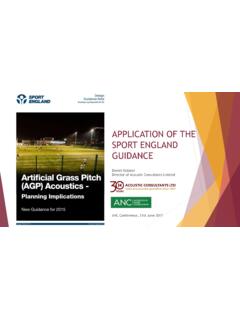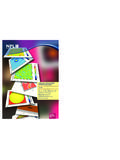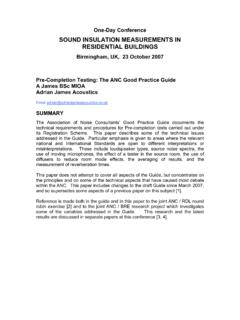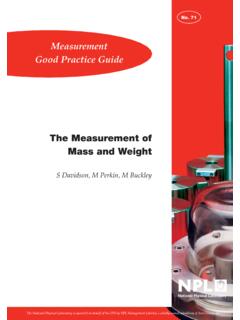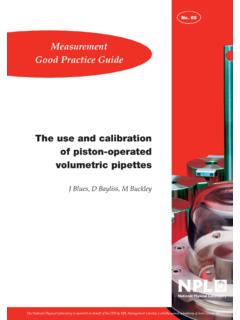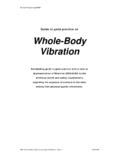Transcription of ANC GOOD PRACTICE GUIDE - Association of …
1 08 Fall ANC good PRACTICE GUIDE Acoustic Testing of Schools This document sets out the technical guidance for acoustic measurements in accordance with Building Bulletin 93 (BB 93). There is currently no ANC scheme in place to assess testers for compliance with these guidelines. The purpose of these guidelines is to enable consistency in interpretation of the methods described in BB 93, Approved Document E (ADE), and relevant ISO standards so that acoustic measurements in school buildings may be made consistently between organisations. This guidance is not intended to be more restrictive than the standards, but to provide guidance for the application of those standards for testing in schools.
2 Version , 11th July 2011 Acoustic Testing of Schools Version 11 July 2011 page 2 of 33 1. Foreword .. 4 4 Competence required .. 4 Schedule of testing .. 4 Performance standards .. 4 Permitted use of this GUIDE .. 5 Association of Noise Consultants .. 5 Format and updating of this GUIDE .. 5 2. Abbreviations and references .. 6 6 References .. 6 3. General Principles .. 8 Standards and references .. 8 4. Requirements for equipment .. 9 Sound level meters, pre-amps and calibration .. 9 Loudspeakers for sound insulation measurements .. 10 Hemisphere polyhedron loudspeakers (special case) .. 10 Noise input pink noise, graphic equalisers etc .. 11 Tapping machines .. 11 Loudspeaker for STI measurements.
3 13 5. Measurement procedures - airborne sound insulation .. 14 General requirements and options .. 14 Room types, sizes and conditions .. 14 Room modes and use of diffusers .. 16 Loudspeaker positions .. 16 Source noise spectrum .. 17 Sound level measurements .. 18 Effect of the tester in the source room .. 20 Background noise measurement .. 20 Measurement of reverberation time .. 21 6. Impact sound transmission of a separating floor .. 22 General requirements and options .. 22 Tests between rooms .. 22 Tapping machine hammer height check .. 22 Tapping machine locations and set-up .. 22 Measurements using moving microphones .. 23 Measurements using fixed microphone positions .. 23 Floor coverings.
4 24 Background noise and reverberation time measurement .. 24 7. Sound insulation calculation procedures and precision .. 25 Calculation procedures .. 25 Rounding and precision .. 25 Calculation of DnT(Tmf,max),w .. 25 8. Indoor ambient noise level measurements .. 26 General requirements .. 26 Naturally ventilated rooms .. 26 Mechanically ventilated rooms .. 27 Precision .. 27 Acoustic Testing of Schools Version 11 July 2011 page 3 of 33 9. Mid-frequency reverberation time measurements .. 28 General requirements .. 28 Measurement method 1: .. 28 Measurement method 2: .. 28 Precision .. 29 10. Speech Transmission Index in open plan spaces .. 30 11. Reporting .. 32 Administrative information required.
5 32 Signature and verification .. 32 Information required for each test .. 32 Graphical reporting of sound insulation results .. 33 Reverberation time test results .. 33 Indoor ambient noise level test results .. 33 STI test results .. 33 Optional 33 Version number Changes Issued by Date Initial issue JHC 18-03-11 Minor corrections JHC 27-04-11 New format and addition of and RO 11-07-11 Acoustic Testing of Schools Version 11 July 2011 page 4 of 33 1. Foreword Introduction This document sets out the technical guidance for acoustic measurements in accordance with Building Bulletin 93 (BB 93). There is currently no ANC scheme in place to assess testers for compliance with these guidelines.
6 The purpose of these guidelines is to enable consistency in interpretation of the methods described in BB 93, Approved Document E (ADE), and relevant ISO standards so that acoustic measurements in school buildings may be made consistently between organisations. This guidance is not intended to be more restrictive than the standards, but to provide guidance for the application of those standards for testing in schools. Competence required The organisation carrying out the testing should be UKAS-accredited for sound insulation testing, or a member of the Association of Noise Consultants Registration Scheme. Competence to carry out sound insulation testing does not necessarily imply competence for speech transmission index (STI) testing.
7 Schedule of testing BB 93 recommends that at least one in four rooms intended for teaching and study purposes should be tested for sound insulation, reverberation time and ambient noise levels and that at least one in ten student positions in open plan spaces should be tested for speech intelligibility. BB 93 recommends that at least one in four teaching / study rooms below a separating floor should be tested. A representative sample of each different construction type and acoustic performance requirement should be tested. Notes on this section i) The statement one in four rooms can be interpreted in a number of ways. It is suggested that the total number of rooms or spaces for teaching and learning is determined, and divided by four (rounding up) to calculate the number of wall (and floor, where appropriate) airborne sound insulation, reverberation time and ambient noise level tests required.
8 Ii) Breakout areas that are used for teaching / study may also be counted as rooms , and may be tested if appropriate. iii) A representative sample of each construction type and acoustic performance requirement would typically include tests of different room types, including assembly and sports halls as well as room types that occur with greater frequency. Performance standards The acoustic performance standards are described in section 1 of BB 93. The room type should be derived from the descriptions in Table , and of BB 93. In addition, the performance standards for ambient noise in naturally ventilated rooms are modified by the subsequent guidance of BB 101. Where there are alternative performance standards, specified in accordance with section of BB 93, these should be should be stated.
9 Acoustic Testing of Schools Version 11 July 2011 page 5 of 33 Permitted use of this GUIDE This GUIDE is Copyright of the Association of Noise Consultants Ltd. Its purpose is to advise ANC members, other consultants and other interested parties. It may be quoted or referenced in other documents but such references do not imply that the ANC endorse those documents. Use of this GUIDE does not mean that a company is member of the Association . Association of Noise Consultants The ANC ( Association of Noise Consultants) is the representative body for consultancy practices providing advice on acoustics, noise and vibration issues. ANC represents well over 100 companies who employ approximately 800 professionally qualified acousticians.
10 For further details of ANC and contact information please go to or email Format and updating of this GUIDE This GUIDE is made available electronically via the ANC website. It is intended to be a dynamic document that will be amended and updated as necessary. Users are invited to send comments, queries and suggestions for changes to the Chairman of the ANC Schools Committee. In general, text in black sets out guidance and, where appropriate, sections are followed by notes in smaller text in blue. These notes do not form part of the formal guidance, but are to provide explanation or discussion of the guidance in each section. Acoustic Testing of Schools Version 11 July 2011 page 6 of 33 2. Abbreviations and references Abbreviations Abbreviations and acronyms used in this GUIDE are explained below.
